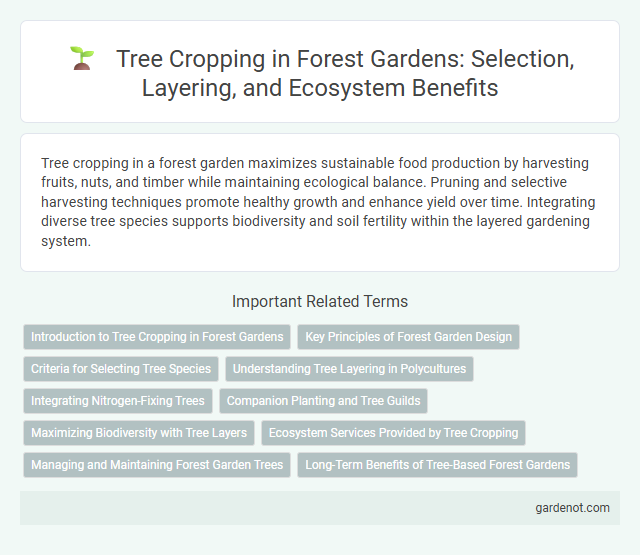Tree cropping in a forest garden maximizes sustainable food production by harvesting fruits, nuts, and timber while maintaining ecological balance. Pruning and selective harvesting techniques promote healthy growth and enhance yield over time. Integrating diverse tree species supports biodiversity and soil fertility within the layered gardening system.
Introduction to Tree Cropping in Forest Gardens
Tree cropping in forest gardens involves the strategic cultivation of trees to maximize yield, biodiversity, and ecosystem services within a sustainable agroforestry system. Key tree species selected for cropping provide fruits, nuts, timber, and medicinal products while enhancing soil fertility and supporting wildlife habitats. Integrating diverse tree crops promotes resilience and long-term productivity in forest garden ecosystems.
Key Principles of Forest Garden Design
Tree cropping in forest garden design emphasizes selecting diverse, compatible species that maximize yield and soil health while minimizing maintenance. Key principles include zoning plants by their functional roles, such as canopy, understory, and ground cover, to optimize light and resource use. Incorporating nitrogen-fixing trees and deep-rooted species enhances nutrient cycling and supports sustainable productivity.
Criteria for Selecting Tree Species
Selecting tree species for a forest garden involves assessing factors such as climate adaptability, soil type compatibility, and growth rate. Prioritizing trees that provide multiple yields--like fruits, nuts, or timber--enhances productivity and sustainability. Resistance to pests and diseases, as well as nitrogen-fixing ability, further contribute to a healthy, balanced ecosystem.
Understanding Tree Layering in Polycultures
Tree layering in polycultures enhances forest garden productivity by mimicking natural forest structures through multiple vertical strata of vegetation. Each layer, from tall canopy trees to understory shrubs and ground covers, supports diverse species interactions that improve nutrient cycling, pest control, and overall ecosystem resilience. Understanding tree layering allows farmers to optimize space, maximize yields, and maintain soil health by integrating complementary species with varying light and root requirements.
Integrating Nitrogen-Fixing Trees
Integrating nitrogen-fixing trees, such as Albizia and Acacia species, into tree cropping systems enhances soil fertility by naturally increasing nitrogen levels, reducing the need for synthetic fertilizers. These trees improve nutrient cycling, support the growth of adjacent crops, and contribute to sustainable agroforestry practices. Their deep root systems also prevent soil erosion and increase water retention, supporting overall ecosystem resilience in forest garden designs.
Companion Planting and Tree Guilds
Tree cropping in forest gardens thrives through companion planting and tree guilds, where diverse plant species are strategically combined to enhance growth, pest resistance, and soil health. Key components of tree guilds include nitrogen-fixing plants, dynamic accumulators, and pollinator attractors that support the main crop tree by improving nutrient cycling and providing natural pest control. This synergistic approach maximizes productivity and ecological balance, creating resilient agroforestry systems.
Maximizing Biodiversity with Tree Layers
Tree cropping in forest gardens enhances biodiversity by utilizing multiple tree layers, including canopy, understory, and shrub layers, to create diverse habitats and microclimates. Maximizing vertical stratification supports a variety of flora and fauna, promoting ecological balance and resilience. Integrating nitrogen-fixing trees and fruit-bearing species further enriches soil health and provides continuous food sources throughout the year.
Ecosystem Services Provided by Tree Cropping
Tree cropping enhances ecosystem services by improving soil fertility through nitrogen fixation and organic matter accumulation, supporting biodiversity by providing habitats for diverse species, and regulating water cycles via increased infiltration and reduced runoff. The presence of trees in agricultural landscapes sequesters carbon, mitigating climate change and promoting air quality through pollutant filtration. These benefits contribute to sustainable land use by stabilizing microclimates, preventing erosion, and supporting pollinator populations essential for crop productivity.
Managing and Maintaining Forest Garden Trees
Regular pruning and selective thinning enhance sunlight penetration and air circulation, promoting healthy growth in forest garden trees. Applying organic mulches and monitoring for pests ensure nutrient retention and disease prevention, supporting long-term productivity. Strategic harvesting of fruits and timber maintains tree vigor while fostering biodiversity within the ecosystem.
Long-Term Benefits of Tree-Based Forest Gardens
Tree cropping in forest gardens enhances soil fertility by increasing organic matter and promoting nutrient cycling, which supports sustainable agriculture over time. The deep root systems of trees improve water retention and reduce erosion, ensuring long-term land stability and resilience. Integrating diverse tree species also boosts biodiversity, creating a balanced ecosystem that benefits both crops and wildlife for years to come.
Tree cropping Infographic

 gardenot.com
gardenot.com